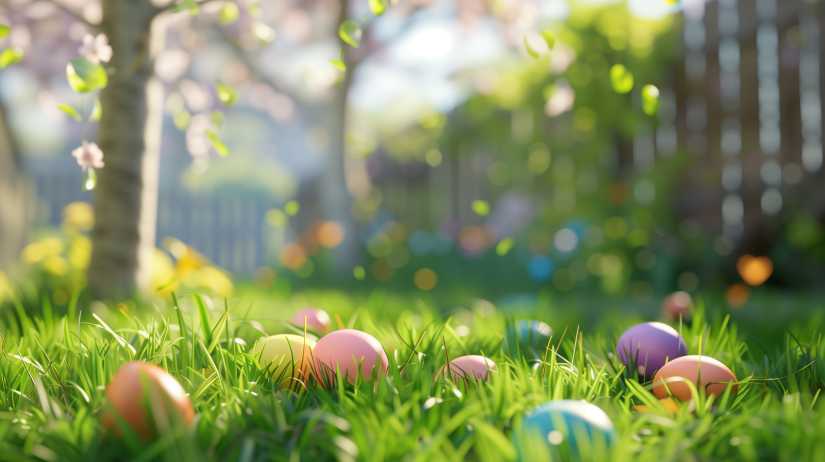The pastel bunnies intrude, supermarkets are filled to the brim with egg-dying kits, and social media feeds are saturated with pristine family Easter schedules. And we, with chronic illness, quietly tallying the energy cost of every tradition and attempting to figure out how we'll make it through the holiday without a flare.
I get it. Easter is just so full of anticipation - sunrise services, big family gatherings, special meals, and photo-op activities for the kids. It's a lot for anyone, but when you're living life with chronic illness, autoimmune disease, or cancer treatment, these expectations can feel downright impossible.
Here's the thing, though - Easter doesn't have to be an all-or-nothing proposition. You don't have to go from full participation to full isolation. Instead, you can create a version of Easter that honors both your body's limitations AND the essence of the season.
Reimagining Easter Traditions (Without Sacrificing the Joy)
The best thing about traditions? They can evolve. They can survive. They can become what works best for your life now - not yesterday or how other folks think it should go.
Some ways to preserve the essence of Easter without draining all the spoons in your desk drawer:
-
Instead of: Forcing yourself to a crowded, early morning church service when your worst time is morning
Try: Attending an evening service instead, choosing a livestream option, or creating a short spiritual moment at home when your body is most capable -
Instead of: Wasting time standing around on long outdoor egg hunts
Try: A mini hunt in the backyard, an egg hunt indoors with eggs at low levels, or being the "photographer" from a comfortable chair -
Instead of: The vinegar smell and standing around involved with the traditional egg dyeing
Try: Coloring eggs with markers, stickers, or washi tape at a table - or using wooden eggs that last year after year -
Instead of: Fancy family potluck dish preparation
Try: Store-bought rolls or a simple fruit platter – or offering to do something in a seated position like folding napkins or filling Easter baskets -
Instead of: Scratch-made Easter brunch
Try: Those tube cinnamon rolls that are kept in the fridge but still make the house smell so wonderful -
Instead of: Waiting in lines to sit on the Easter Bunny
Try: Using what you have around your home or yard for a simple Easter photo backdrop -
Instead of: Sugar-laden Easter baskets that may produce symptoms
Try: Themed baskets of plush treats like fuzzy socks, goofy stickers, or food-allergy-safe snacks that won't trigger your body to stage a rebellion
The magic isn't doing it all the old-fashioned way – it's finding the essence of each tradition and making it work for you.
Family Without the Guilt Trip
One of the hardest parts about getting through holidays is communicating your needs to in-laws and other relatives who don't fully understand your limitations. The outer and inner guilt trips can at times be even more intolerable than the symptoms themselves.
A few tactics that might be useful:
- Be clear but brief: "I'd like it to come over for Easter dinner, but mornings are difficult with my condition. Would 2pm do instead of 11am?"
- Offer alternatives: "I'm not able to coordinate the big egg hunt in the park, but I can help with stuffing the eggs the night before."
- Set expectations early: "Just a heads up, I'll probably take short rest breaks throughout our event – it helps me to be fully there for the moments that matter most."
- Take what you need: If certain foods trigger symptoms, bring your own safe food with you instead of relying on everyone else to adjust.
- Plan an exit: Let someone know ahead of time that you might be leaving early if symptoms worsen so that you don't feel trapped.
Keep in mind that the individuals who really care for you want you there in whatever form is feasible – they don't wish for you to be enduring rituals at the cost of your health.
Finding the Beauty in "Good Enough"
Maybe the hardest part of moving holidays is letting go of that idealized image we see everywhere. The spotless home and elegant decor. The Pinterest-perfect Easter table setting. The ability to participate in every single tradition without missing a beat.
I've been working on embracing "good enough" holidays instead – and finding surprising joy in doing so.
There is beauty in viewing an egg hunt from a porch swing instead of keeping up on foot. There is intimacy in savoring takeout ham dinner instead of hours spent cooking. There is worth in a moment of silence at home instead of a full service.
A slower Easter isn't a less Easter. Sometimes it's more meaningful because you're present enough to actually live it instead of just surviving it.
Your Version of Easter Is Valid
However you do end up celebrating Easter this year – with deep changes, cherished traditions, or a mix of both – you can be certain that your version is correct.
- You're not doing Easter wrong if you need to take it easy halfway through the day.
- You're not missing out if you adapt activities to your levels of energy.
- You're not letting anyone down by protecting your health.
You're just celebrating in a way that honors the holiday and the fact that you get to inhabit your body. And that is smart, not weak.
On behalf of everyone at BeWell, we wish your Easter is filled with more moments of joy that don't cost you your wellbeing. Because holidays are meant to lift you up, not suck the life out of you.
How are you incorporating Easter traditions into this year? We'd love to hear your creative solutions in the comments.



When Sunshine Feels Like a Flare: Managing Heat Sensitivity with Chronic Illness
Chronic Illness and Earth Month: Eco-Friendly Habits That Don't Burn Spoons
1 comment
Amazing article-so true. I can’t tell you how many holidays (even this past Christmas) that I’ve ruined because I over did it; trying to make it perfect for everyone. They didn’t even expect anything from me 🤦🏻♀️ I did it to myself.
Thank you